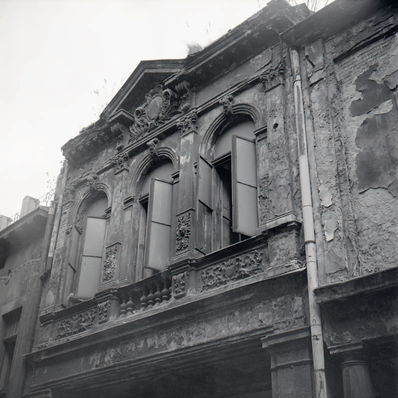Buildings nos. 59 and 61
The first known owner of building no. 59 was a brewer named Pavel Jelínek. We know that he was in possession of the building in 1644. It became derelict during the Thirty Years’ War (1618–1648), and in 1673 it was purchased by the butcher Ondřej Šebesta for just 80 gulden. In 1675 his widow Alžběta Šebestová sold it to her son-in-law Jakub Foglar for 300 gulden. A condition of the sale was that she retained her own quarters in “the front living room with one chamber”. At the time, the property also included a garden near a mill where Mlýnská Street is now located, a barn in Fifejdy (now a district of Ostrava), a field in Kamenec (also now part of Ostrava), and a pasture. According to a valuation drawn up in 1823 and a map dating from 1836, we know that the building (valued at 3 000 gulden) was built of masonry and had one floor and a wooden arcade supported by three pillars. In 1865 the owner Sigmund Königstein planned to add another single-floor building, but eventually the house was completely rebuilt from the foundations up. In 1882 it was purchased by the café-owner Anton Zuber, but it was not until 1894 that the next owner (Adolf Bellak) adapted the building for use as a café, using a design by Felix Neumann.
In 1614, building no. 61 was owned by one Pavel Vandral. It then passed into the hands of his son Jan, who was a shoemaker and served as the Burgomaster of Ostrava from 1656 to 1662. The first written mention of an arcade dates from 1710, when Valentin Žila sold the building to his son Jan on the condition that for the period of one year he would retain living quarters in “a chamber above the lower hall”. Because even in 1820 the building still had just one floor, the chamber was evidently located in the loft space. Between 1833 and 1836, when the building was owned by the clothmaker Ignác Metzner, it was rebuilt and the wooden arcade was replaced by a masonry structure supported by three pillars. It was not until 1893 that Karl Berger had the single-floor house demolished and constructed a two-floor building in its place.
In February 1911, Samuel Gronner opened the “White Rose” inn at building no. 61, facing onto Pivovarská Street. On the upper floor was the Hotel International, which included a café. Both establishments soon gained a reputation as “a meeting-place for all kinds of unscrupulous rabble”, and the hotel’s rooms were rented out by the hour. In June 1912 the police closed the inn and the hotel down due to “the highly reckless way” in which Samuel Gronner promoted prostitution. In January 1913 a fire broke out in the building’s loft, for reasons unknown. The upper floor was so badly damaged that it needed to be completely rebuilt. There was another fire in the building in November of the same year. Following repairs, both establishments were re-opened to the public.
Akce: Otevřít verzi pro tisk

